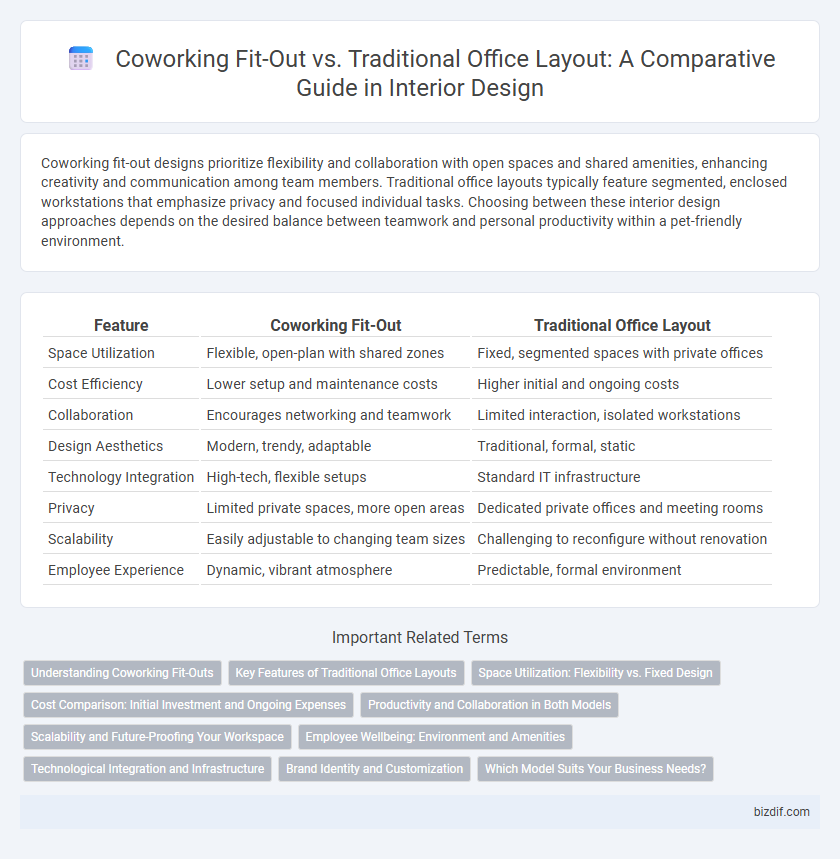Coworking fit-out designs prioritize flexibility and collaboration with open spaces and shared amenities, enhancing creativity and communication among team members. Traditional office layouts typically feature segmented, enclosed workstations that emphasize privacy and focused individual tasks. Choosing between these interior design approaches depends on the desired balance between teamwork and personal productivity within a pet-friendly environment.
Table of Comparison
| Feature | Coworking Fit-Out | Traditional Office Layout |
|---|---|---|
| Space Utilization | Flexible, open-plan with shared zones | Fixed, segmented spaces with private offices |
| Cost Efficiency | Lower setup and maintenance costs | Higher initial and ongoing costs |
| Collaboration | Encourages networking and teamwork | Limited interaction, isolated workstations |
| Design Aesthetics | Modern, trendy, adaptable | Traditional, formal, static |
| Technology Integration | High-tech, flexible setups | Standard IT infrastructure |
| Privacy | Limited private spaces, more open areas | Dedicated private offices and meeting rooms |
| Scalability | Easily adjustable to changing team sizes | Challenging to reconfigure without renovation |
| Employee Experience | Dynamic, vibrant atmosphere | Predictable, formal environment |
Understanding Coworking Fit-Outs
Coworking fit-outs prioritize flexible, open-plan spaces designed to enhance collaboration and adaptability, incorporating modular furniture and shared amenities that support diverse work styles. Unlike traditional office layouts characterized by fixed cubicles and private offices, coworking environments foster community interaction and dynamic use of space. Effective coworking fit-outs optimize natural light, integrate technology hubs, and promote ergonomic comfort to boost productivity and employee satisfaction.
Key Features of Traditional Office Layouts
Traditional office layouts emphasize designated private offices and cubicles to enhance focus and privacy, supported by structured furniture arrangements like desks and filing cabinets. Fixed partitions and formal meeting rooms facilitate hierarchical communication, while uniform lighting and standardized decor uphold a consistent professional atmosphere. These elements collectively support routine workflows and clear supervisory oversight in a conventional corporate environment.
Space Utilization: Flexibility vs. Fixed Design
Coworking fit-outs maximize space utilization through flexible layouts that adapt to various work styles and team sizes, promoting dynamic collaboration and efficient use of square footage. Traditional office layouts emphasize fixed design with predetermined desks and private offices, often resulting in underutilized areas during off-peak times. Flexible furniture systems and modular partitions in coworking spaces enhance adaptability, contrasting with the static arrangement typical of conventional office environments.
Cost Comparison: Initial Investment and Ongoing Expenses
Coworking fit-out typically requires lower initial investment due to shared infrastructure, flexible furniture, and reduced customization needs compared to traditional office layouts, which demand extensive partitioning and bespoke design elements. Ongoing expenses in coworking spaces remain cost-effective through shared utilities, maintenance fees, and scalable services, whereas traditional offices incur higher costs from dedicated facility management, fixed utility bills, and long-term equipment upkeep. Analyzing total cost of ownership clearly shows coworking fit-outs optimize operational expenditure, especially for startups and small businesses prioritizing budget efficiency.
Productivity and Collaboration in Both Models
Coworking fit-outs prioritize open, flexible spaces that enhance spontaneous collaboration and boost productivity by fostering dynamic interactions among diverse teams. Traditional office layouts often segment employees into defined areas, which can limit cross-departmental communication but provide focused environments suited for individual tasks. Both models impact productivity and collaboration uniquely, with coworking spaces promoting creative synergy and traditional offices supporting structured workflow efficiency.
Scalability and Future-Proofing Your Workspace
Coworking fit-outs offer enhanced scalability by allowing businesses to easily expand or downsize without extensive renovations, unlike traditional office layouts that often require costly and time-consuming modifications. Modular furniture and flexible space planning in coworking environments support future-proofing by adapting to evolving workstyles and technological advancements. Integrating adjustable partitions, shared amenities, and smart office systems ensures long-term functionality and efficient space utilization in modern workspaces.
Employee Wellbeing: Environment and Amenities
Coworking fit-outs prioritize employee wellbeing by incorporating flexible environments, natural light, and ergonomic furniture that boost comfort and productivity. Amenities such as wellness rooms, communal kitchens, and green spaces enhance mental health and foster social interaction among workers. Traditional office layouts often lack these dynamic features, potentially limiting overall employee satisfaction and wellbeing.
Technological Integration and Infrastructure
Coworking fit-outs prioritize advanced technological integration, featuring robust Wi-Fi networks, IoT-enabled devices, and flexible plug-and-play infrastructure to support diverse users and dynamic workstyles. Traditional office layouts often rely on static technology setups and fixed workstations with limited adaptability, resulting in slower upgrades and higher maintenance costs. Modern coworking spaces leverage smart conference rooms, wireless charging stations, and seamless cloud connectivity to enhance productivity and collaboration in real-time.
Brand Identity and Customization
Coworking fit-out solutions offer enhanced customization that directly reflects a brand's identity through flexible layouts, vibrant communal spaces, and tailored design elements, fostering collaboration and innovation. Traditional office layouts often prioritize uniformity and fixed structures, limiting opportunities for expressive brand integration and adaptive spatial configurations. By embracing coworking design principles, businesses can create dynamic environments that strengthen brand presence and employee engagement.
Which Model Suits Your Business Needs?
Coworking fit-outs offer flexible, collaborative spaces designed to boost creativity and networking, ideal for startups and businesses seeking agility. Traditional office layouts provide structured, private workstations that enhance focus and control, suiting established companies with defined workflows. Evaluating your team's work style, growth plans, and privacy requirements helps determine which model aligns best with your business strategy.
Coworking fit-out vs Traditional office layout Infographic

 bizdif.com
bizdif.com